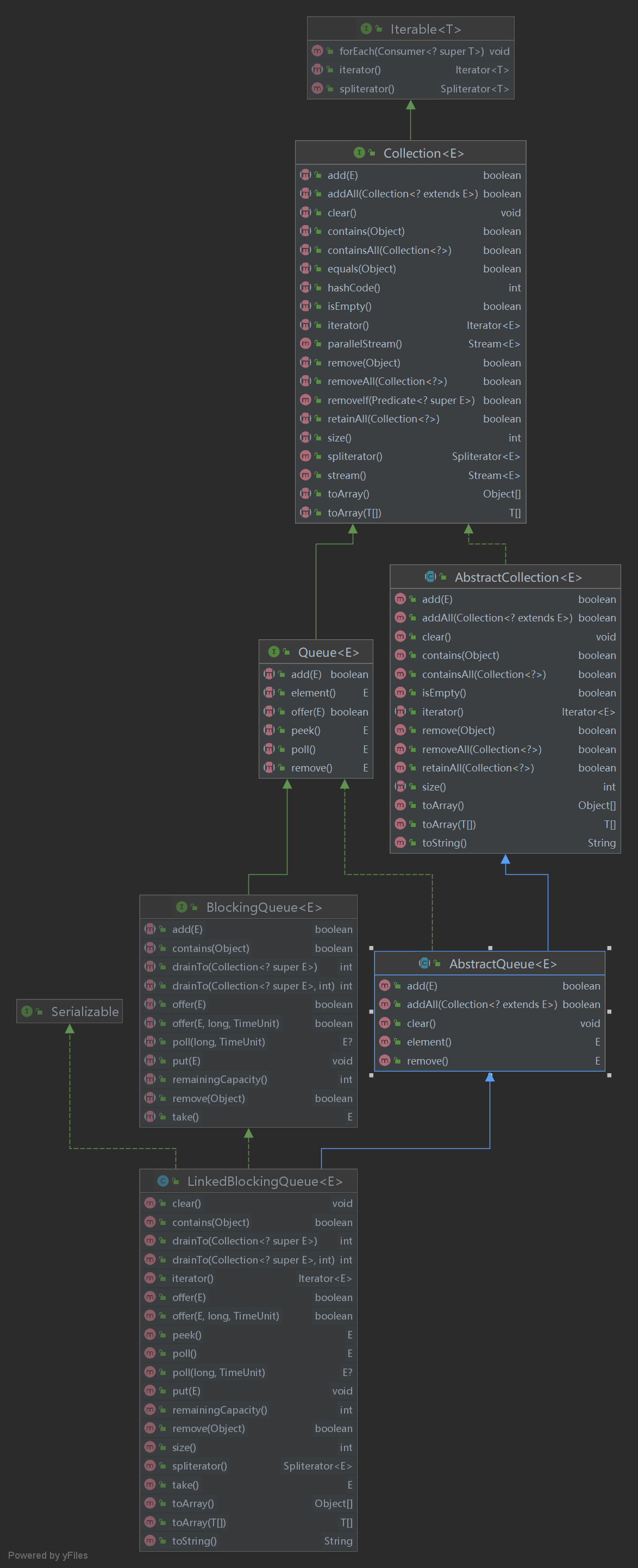JAVA并发(5)-并发队列LinkedBlockingQueue的分析
本文介绍LinkedBlockingQueue,这个队列在线程池中常用到。(请结合源码,看本文)
1. 介绍
LinkedBlockingQueue, 不支持null,基于单向链表的可选有界阻塞队列。队列的顺序是FIFO。基于链表的队列通常比基于数组的队列有更高的吞吐量, 但在大多数的并发应用中具有更低的可预测性能较差(这句话,在最后解释一下)
如果不选择队列的容量,默认值是Integer.MAX_VALUE,为了防止队列的过度扩张.
还实现了Collection接口与Iterator接口中所有的可选方法。
1.1 结构
public class LinkedBlockingQueue<E> extends AbstractQueue<E>
implements BlockingQueue<E>, java.io.Serializable
LinkedBlockingQueue类图

LinkedBlockingQueue的构造器
public LinkedBlockingQueue() {
this(Integer.MAX_VALUE);
}
public LinkedBlockingQueue(int capacity) {
if (capacity <= 0) throw new IllegalArgumentException();
this.capacity = capacity;
// head与last指向哨兵节点
last = head = new Node<E>(null);
}
public LinkedBlockingQueue(Collection<? extends E> c)
...
1.2 保证线程安全
LinkedBlockingQueue的底层使用ReetrantLock保证线程安全,其实就是一个"消费-生产"模型,通过本文我们还可以学到ReetrantLock的实际使用场景。
/** Lock held by take, poll, etc */
private final ReentrantLock takeLock = new ReentrantLock();
/** Wait queue for waiting takes */
private final Condition notEmpty = takeLock.newCondition();
/** Lock held by put, offer, etc */
private final ReentrantLock putLock = new ReentrantLock();
/** Wait queue for waiting puts */
private final Condition notFull = putLock.newCondition();
/**
* Signals a waiting take. Called only from put/offer (which do not
* otherwise ordinarily lock takeLock.)
*/
private void signalNotEmpty() {
final ReentrantLock takeLock = this.takeLock;
takeLock.lock();
try {
notEmpty.signal();
} finally {
takeLock.unlock();
}
}
/**
* Signals a waiting put. Called only from take/poll.
*/
private void signalNotFull() {
final ReentrantLock putLock = this.putLock;
putLock.lock();
try {
notFull.signal();
} finally {
putLock.unlock();
}
}
2. 源码分析
在讲LinkedBlockingQueue前,我们先看看需要它实现的接口BlockingQueue
2.1 BlockingQueue
实现了BlockingQueue的类,必须额外支持在查找元素时,等待队列直到非空为止的操作;在储存元素的时候,要等待队列的空间可用为止。
它的方法有四种形式,处理不能立即满足但是未来可能满足的操作的方式各有不同。
- 直接抛出异常
- 返回一个特殊值(null 或者 false)
- 一直等待,直到操作成功
- 超时设定,超过时间就放弃

我们知道了不同方法,不能立即满足的不同的处理方式,这样我们下面就更好理解LinkedBlockingQueue的源码了。
下面我们从
- offer(e)
- offer(e, time, unit)
- put(e)
- poll()
去分析一下LinkedBlockingQueue
2.2 offer(e)
添加成功就返回true; 插入值为null,报错;或队列已满,直接返回false,不会等待队列空闲
public boolean offer(E e) {
if (e == null) throw new NullPointerException();
final AtomicInteger count = this.count;
// 队列的容量满了,就直接返回了
if (count.get() == capacity)
return false;
int c = -1;
Node<E> node = new Node<E>(e);
final ReentrantLock putLock = this.putLock;
putLock.lock();
try {
if (count.get() < capacity) {
enqueue(node);
c = count.getAndIncrement();
if (c + 1 < capacity)
notFull.signal();
}
} finally {
putLock.unlock();
}
if (c == 0)
signalNotEmpty();
return c >= 0;
}
代码较简单,就不细讲了。
2.3 offer(e, time, unit)
若队列已满,还没超过设定的时间,就等待,等待时,会对中断作出反应;若超过了设定的时间,操作就跟offer(E e)一样了
public boolean offer(E e, long timeout, TimeUnit unit)
throws InterruptedException {
if (e == null) throw new NullPointerException();
long nanos = unit.toNanos(timeout);
int c = -1;
final ReentrantLock putLock = this.putLock;
final AtomicInteger count = this.count;
putLock.lockInterruptibly();
try {
while (count.get() == capacity) {
// 队列已满,超过了特定的时间才会返回false
if (nanos <= 0)
return false;
nanos = notFull.awaitNanos(nanos);
}
enqueue(new Node<E>(e));
c = count.getAndIncrement();
if (c + 1 < capacity)
notFull.signal();
} finally {
putLock.unlock();
}
if (c == 0)
signalNotEmpty();
return true;
}
2.4 put(e)
一直等待直到成功或者被中断
public void put(E e) throws InterruptedException {
if (e == null) throw new NullPointerException();
// Note: convention in all put/take/etc is to preset local var
// holding count negative to indicate failure unless set.
int c = -1;
Node<E> node = new Node<E>(e);
final ReentrantLock putLock = this.putLock;
final AtomicInteger count = this.count;
putLock.lockInterruptibly();
try {
// 防止虚假唤醒
while (count.get() == capacity) {
notFull.await();
}
enqueue(node);
c = count.getAndIncrement();
if (c + 1 < capacity)
notFull.signal();
} finally {
putLock.unlock();
}
if (c == 0)
signalNotEmpty();
}
我没有想到,上面发生虚假唤醒的场景(如果知道的同学,请告诉我一下,谢谢了)。
it is recommended that applications programmers always assume that they can occur and so always wait in a loop. --Condition
反正使用Condition在循环里等待就对了
2.5 poll()
队列为空时,直接返回null,不会await;非阻塞方法
public E poll() {
final AtomicInteger count = this.count;
if (count.get() == 0)
return null;
E x = null;
int c = -1;
final ReentrantLock takeLock = this.takeLock;
takeLock.lock();
try {
if (count.get() > 0) {
x = dequeue();
c = count.getAndDecrement();
if (c > 1)
notEmpty.signal();
}
} finally {
takeLock.unlock();
}
if (c == capacity)
signalNotFull();
return x;
}
其余的方法其实都是类似的,直接看上面BlockingQueue的四种方式。
最后再讲一个方法remove(Object o), 将会提及一个知识点。
2.6 remove
删除o, 若成功就返回true,反之.
public boolean remove(Object o) {
if (o == null) return false;
fullyLock();
try {
// 算法题,删除某一个链表的结点,可以看一下源码,记录两个结点,一个在前,一个在后。
for (Node<E> trail = head, p = trail.next;
p != null;
trail = p, p = p.next) {
if (o.equals(p.item)) {
unlink(p, trail);
return true;
}
}
return false;
} finally {
fullyUnlock();
}
}
上面的代码是简单的对链表的操作,我们主要是看fullyLock() 与 fullyUnlock()的代码
/**
* Locks to prevent both puts and takes.
*/
void fullyLock() {
putLock.lock();
takeLock.lock();
}
/**
* Unlocks to allow both puts and takes.
*/
void fullyUnlock() {
takeLock.unlock();
putLock.unlock();
}
我们都知道解锁顺序应该与获取锁顺序相反,那么是为什么啦
其实我并不觉得,上面的fullyUnlock解锁顺序与获取锁的顺序如果是相同的会出什么问题,也并不会出现死锁(如果释放锁与获取锁,中间还存在其他操作就另当别论了)。那它仅仅是为了代码的好看?
假如,我们有下面这段代码(解锁与获取锁中间有其他操作)
A.lock();
B.lock();
Foo();
A.unlock();
Bar();
B.unlock();
假设Bar()是要去重新获取A锁的。
时刻一: 线程X运行到了Bar(),A锁没有被其他线程获取,此时线程X持有B锁,要去获取A锁
时刻二: 线程Y运行到代码的最前面,A.lock(),获取到了A锁,此时线程Y持有A锁,要去获取B锁,此时才会造成死锁。
解锁顺序与获取锁顺序相反,为的是
- 避免上面那种情况造成死锁
- 为了美观
3. 总结
LinkedBlockingQueue线程安全的队列
- 使用putLock、takeLock分别对增加和删除操作保证其线程安全性
- 是一个有界(默认值为Integer.MAX_VALUE)的底层基于单向链表的队列
解释一下,相对于基于数组的队列,链表队列的可预测性能较差(less predictable performance in most concurrent applications)这句话
我认为是,数组是在初始化会分配"一块连续的内存",而链表是在队列添加元素时动态的分配内存地址的,是不连续的;还有就是它将会处理更多的内存结构,每个元素存在一个链表的节点。
This means that it has to flush more dirty memory pages between processors when synchronizing.




 浙公网安备 33010602011771号
浙公网安备 33010602011771号